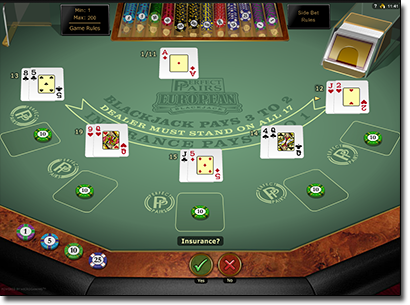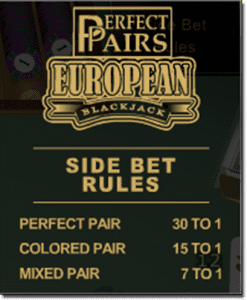Perfect pairs blackjack is a game with a main bet and a side bet. As with most side bets, the payout percentage isn’t as good as hoped-for, but the payouts are substantial.
Featured Casinos
How to place a Perfect Pairs bet

In land-based casinos, you’ll find this game offered most often in casino in the United Kingdom (London), and Macau. This variation of twenty-one offers a side bet with a large payout. At the same time, the house edge on the side bet is lower than it is on the main bet.
To win the side bet, your starting pair of cards need to match. A coloured pair is one where the pair of cards are the same colour, too. A “perfect pair” means they match suit, colour, and rank. Different jackpot payouts accrue to a gambler if they make this side bet. Below are the rules of the game, strategy advice, and other tips when playing this game.
Deck size
The standard size multi-deck is 8 decks of cards. These are the conventional 52-card decks with no wild cards. In most cases, the perfect pairs shoe contains 8 decks. While this increases the house edge, it also provides a lot of potential matches for your hole card.
Classic blackjack
The main bet in perfect pairs is played like classic blackjack. The natural twenty-one pays 3:2. Insurance is offered at 2:1, though you should never use this option unless you are a skilled card counter playing offline. In an online setting, never take insurance. The dealer hits on a soft 17, while normal splitting and doubling rules apply. It’s the side bet which makes perfect pairs distinct other from traditional twenty-one games.
Side bet – top jackpot
The top jackpot on perfect pairs is 25x the bet size, if you receive a pair of cards which have matching, suit, colour, and rank. The payoff comes whether the pair of cards are 2s, 5’s, queens, or aces. Any card rank works, as long as they are perfect matches. On occasion, players will find casinos which offer a 30x payout instead of the 25 times payment. Be aware that at least one version of the three known 25x pay schedules actually have a lower house edge than the 30 times pay table. The key factor you’re looking for in this superior pay schedule is whether the payout on the red/black are 5x or 6x. The six times payout is the full-pay table.
Coloured pair payout
The coloured pair is where you don’t have the same suit, but you do have matching colours on your pair. If you receive a club/spade or a diamond/heart card combination, you’ll receive the middle-tiered payout of either 10x, 12x, or 15x times the original wager. It can get tricky to gauge which is best, because the 12 times wager are found on the best and the 3rd-best payout chart. The 10x payout is found on the second-best chart, while the 15x payout is found on the worst pay chart. Know what you want to find when playing perfect pairs. I’ll give you the best pay chart when we get to the third and final payment on the schedule: the mixed pair payout.
Red/black payout
Above, I mentioned the red/black payments of either 5 times or 6 times the bet. When I write red/black, this is the mixed pair. In other words, the card rank matches, but one card is red and the other is black. This is the lowest payout for the side bet, but it’s an important one, because it occurs more often than the perfect pair or coloured pair combination.
It’s a common tactic for game designers to offer higher payouts further up the pay table, because many inexperienced gamblers assume these are all-important. Often, it’s the payout in the middle or at the bottom of the chart which you should note. In this case, if you find the 25x for perfect, 12x for coloured, and 6x for mixed pairs, this is the full pay table.
Side bet house edge
Blackjack players should know that side bets in 21 almost always have a higher house edge than the main bet. Most people know the house edge on many games of twenty-one are less than 1%, meaning you can expect to win back $99 out of every $100 wagered. What people might not know is the house edge on perfect pairs is over 6%, meaning they can expect to win back only $94 out of every $100 wagered.
This represents a significant different over the course of a gaming session, much less a gambling holiday to Monte Carlo, Las Vegas, or Macau. I’m not saying you shouldn’t play this version of 21, but you should know what you’re up against and accept the longer odds. Twenty-one is a game where players grind out small wins with 1:1 payouts (and the occasional 3:2 payout), so these side bets offer a chance to win much larger payouts on certain hands–at a price.
Play Perfect Pairs for free
Those who want to play for free should try Perfect Pairs in demo mode at one of our recommended online casinos like All Slots Casino. Playing for free gives you the chance to learn the rules of the game, hone your strategy or simply enjoy the entertainment factor. If you plan on punting for real money, you can create an account at a reputable online casino and start using their gaming software for free.
To play Perfect Pairs for free, all you need to do is head to a safe casino like the ones recommended on our site. Games can be played instantly over your web browser, or by downloading the free premium casino software. You don’t have to deposit money and you’re under no obligation to pay for the gaming. In fact, some sites offer players incentives in the form of a no-download bonus. While restrictions apply to protect the casino, this gives real money in a player account which can be withdrawn with no obligation, if the player wins. You won’t find this at all online blackjack casinos, but it’s a common practice to offer freeplay bonuses of $5 or $10 to attract new registrants.
This means you can go to an online casino like All Slots Casino or Royal Vegas and start playing perfect pairs for free using house money. Learn the software while you learn the game, then start playing for real money if you decide it’s a game you enjoy. If you decide not to fund your account and gamble, that’s alright, too.

